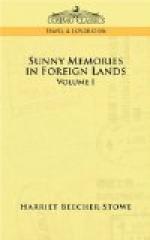I am increasingly sorry that I was beguiled out of my personal examination of this chapel, since I have seen the plates of it in my Baronial Sketches. It is the rival of Melrose, but more elaborate; in fact, it is a perfect cataract of architectural vivacity and ingenuity, as defiant of any rules of criticism and art as the leaf-embowered arcades and arches of our American forest cathedrals. From the comparison of the plates of the engravings, I should judge there was less delicacy of taste, and more exuberance of invention, than in Melrose. One old prosaic commentator on it says that it is quite remarkable that there are no two cuts in it precisely alike; each buttress, window, and pillar is unique, though with such a general resemblance to each other as to deceive the eye.
It was built in 1446, by William St. Clair, who was Prince of Orkney, Duke of Oldenburgh, Lord of Roslin, Earl of Caithness and Strathearn, and so on ad infinitum. He was called the “Seemly St. Clair,” from his noble deportment and elegant manners; resided in royal splendor at this Castle of Roslin, and kept a court there as Prince of Orkney. His table was served with vessels of gold and silver, and he had one lord for his master of household, one for his cup bearer, and one for his carver. His princess, Elizabeth Douglas, was served by seventy-five gentlewomen, fifty-three of whom were daughters of noblemen, and they were attended in all their excursions by a retinue of two hundred gentlemen.
These very woods and streams, which now hear nothing but the murmurs of the Esk, were all alive with the bustle of a court in those days.
The castle was now distinctly visible; it stands on an insulated rock, two hundred and twenty yards from the chapel. It has under it a set of excavations and caverns almost equally curious with those of Hawthornden; there are still some tolerably preserved rooms in it, and Mrs. W. informed me that they had once rented these rooms for a summer residence. What a delightful idea! The barons of Roslin were all buried under this Chapel, in their armor, as Scott describes in the poem. And as this family were altogether more than common folks, it is perfectly credible that on the death of one of them a miraculous light should illuminate the castle, chapel, and whole neighborhood.
It appears, by certain ancient documents, that this high and mighty house of St. Clair were in a particular manner patrons of the masonic craft. It is known that the trade of masonry was then in the hands of a secret and mysterious order, from whom probably our modern masons have descended.
The St. Clair family, it appears, were at the head of this order, with power to appoint officers and places of meeting, to punish transgressors, and otherwise to have the superintendence of all their affairs. This fact may account for such a perfect Geyser of architectural ingenuity as has been poured out upon their family chapel, which was designed for a chef-d’oeuvre, a concentration of the best that could be done to the honor of their patron’s family. The documents which authenticate this statement are described in Billings’s Baronial Antiquities. So much for “the lordly line of high St. Clair.”




